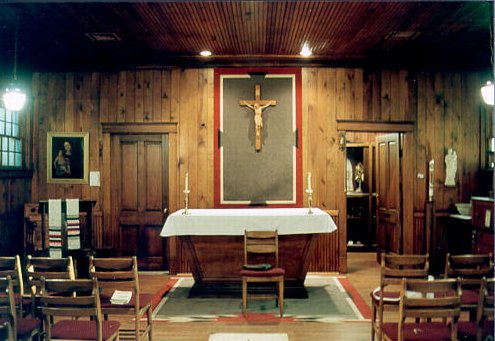
Throughout its many years on campus Notre Dame’s Log Chapel has been the site of countless University related religious services: weddings, anniversaries, baptisms and prayer services have been held within its four walls. It has become a sacred place filled with the cherished memories of faculty, staff, alumni and friends of Notre Dame.
This hallowed spot, nestled among the trees is just a stone’s throw away from other icons at the heart of the campus: Old College, The Dome, Basilica, and The Grotto. The present Log Chapel is a historical replica of the original log cabin-chapel Fr. Stephen Badin built in 1831 when he established his mission at Lake St. Mary and named it Ste.-Marie-des-Lacs. Father Sorin and his seven Brothers resided in Badin’s Log Chapel at the mission site when they arrived in 1842 while they were establishing the University of Notre Dame.An excerpt from a large plaque opposite the Founder’s Monument along the walkway to the Log Chapel records Fr. Edward Sorin’s description of his arrival at “The Indian Chapel” at Ste.-Marie-des-Lacs:
In about the year 1685, according to correspondence of the early French Jesuit missionaries, one of the first missions in northern Indiana was founded for the neighboring Potawatomi and Miami Indians on the St. Joseph River at a point south of the present city of Niles, Michigan. A few years later, Father Claude Allouez, S.J., “the so-called Francis Xavier of the American Indians,” according to authentic tradition, came to permanently establish this mission post, known as the St. Joseph Mission. It was abandoned in 1759 after the British defeated the French.
Fr. Thomas T. McAvoy, C.S.C. has written, “A tradition handed down to the Fathers of Holy Cross says that there were bands of Indians living on the shores of the present lakes of Notre Dame before Rev. Stephen Badin, first priest ordained in the United States, came to live there.”
It was also long known to be a meeting place for explorers, traveling missionaries and early white settlers. For this reason, many believe -- although it has not yet been proven by written record -- that Father Claude Allouez would have visited the encampments of Indians at St. Mary’s Lake during his travels throughout the St. Joseph Valley.
Author, Agnes Repplier, speaks of Pere Allouez’s “gift of eloquence”:
“The Indians were so interested in his instruction that they would not let him go to bed at night, but sat in solemn circles waiting to hear more and the sleepy priest could not, in conscience resist gratifying their thirst for enlightenment.”
Father McAvoy describes the lives of these dedicated black robe missionaries far from their homeland in France. How they spent their energy in all kinds of weather. “They lived in the huts of the natives and shared their primitive food, enduring their savage humors and trying to impose upon their primitive knowledge the saving message of the Gospel. When one died or was killed another came to take his place.”
Father Allouez, died April 27, 1689. His body, it is believed, is buried on the banks of the St. Joseph River, near the old Fort St. Joseph Mission, just south of the present city of Niles, Michigan.
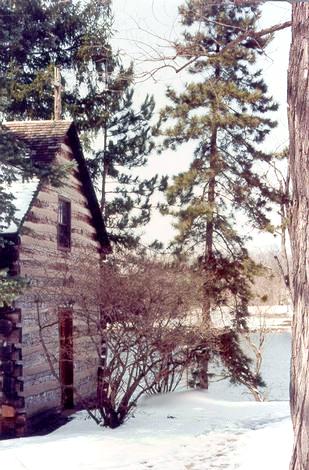 It was Father Badin who moved the St. Joseph Mission near Niles, which he was sent to reorganize in 1830, to the new mission center of Northern Indiana and Southern Michigan, when he purchased the land at St. Mary’s Lake -- the site of the present University of Notre Dame -- which he named Ste.-Marie-des-Lacs. When Father Sorin arrived he renamed the site Notre Dame du Lac. Thus we find in this mission center’s three periods of history, three names, St. Joseph Mission, St. Mary’s of the Lakes and Notre Dame du Lac.
It was Father Badin who moved the St. Joseph Mission near Niles, which he was sent to reorganize in 1830, to the new mission center of Northern Indiana and Southern Michigan, when he purchased the land at St. Mary’s Lake -- the site of the present University of Notre Dame -- which he named Ste.-Marie-des-Lacs. When Father Sorin arrived he renamed the site Notre Dame du Lac. Thus we find in this mission center’s three periods of history, three names, St. Joseph Mission, St. Mary’s of the Lakes and Notre Dame du Lac.
The first church not only at Notre Dame but in Northwest Indiana was a log chapel erected by Badin as early as 1832. Father Badin’s chapel fell into disuse in 1848. It was destroyed by fire in 1856. It was known as the “Indian Chapel.”
The present chapel is a replica of Badin’s Log Chapel which burned to the ground. It will be 100 years old in 2006. It was reconstructed in 1906, hand-hewn with a broadaxe by William Arnett an ex-slave from Kentucky. It is such an authentic reconstruction that even today many people on campus believe it is the original Log Chapel.
The Founder’s Monument which marked the spot of “The Indian Chapel” is still there. It was recently relocated nearby to make room for the addition to the School of Architecture.
From 1987 to 1992, the Sacred Heart Church was being renovated in preparation for the sesquicentennial celebration in 1992. At the same time, funds were given to the University to renovate the historic replica of Badin’s Log Chapel.
When air conditioning was being installed in the basement of the Sacred Heart Church a decision was made to move the bodies of DeSeille, Petit and Cointet in the basement crypt to the church upstairs. However, Father Hesburgh decided it would be more appropriate to move them to the Log Chapel because they were associated with Badin’s early mission at Ste.-Marie-des-Lacs. It was the last thing he did before he retired as President of the University. Badin’s remains which were brought from St. Louis when the replica of the Log Chapel was built in 1906 are also there.
This excerpt from a German Missionary’s diary written in 1840, shortly after the untimely demise of Fr. DeSeille and Fr. Petit, is preserved in the University of Notre Dame Archives. It describes the circumstances of both their deaths:
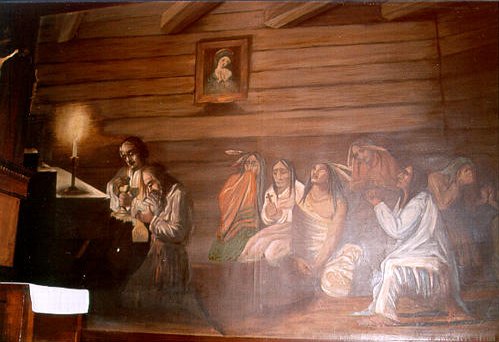
[Father] Petit, formerly the famous lawyer and popular speaker at Rennes (Ille-et-Vilaine) in France, after half a year of his presence in the same house, preached in the language of the Potawatomis; and then, as a victim of the purest humanity on an onerous trip which he made with the savages across the Mississippi to St. Louis, a city on that river, he was physically defeated, only to celebrate his resurrection in the hereafter all the more victoriously. Those men have to be praised very highly, who have struggled with the greatest troubles in this house. -- 1840 German Missionary’s Diary
The three priests, Louis DeSeille, Benjamin Petit and Francois Cointet, the latter a Holy Cross priest, left a deep impression on the early history of Notre Dame. DeSeille, a Belgian, came to work for Fr. Stephen Badin in 1832. Until his unexpected death in 1837 he served the Indians in Bertrand and Pokagon, Michigan and at Ste.-Marie-des-Lacs, the future site of Notre Dame.
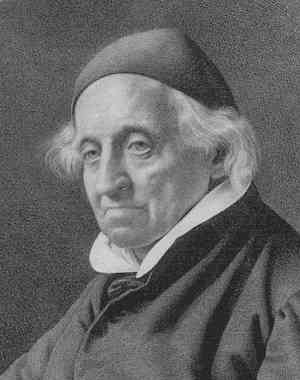 One day after visiting the Catholics in South Bend and Bertrand, Fr. DeSeille stopped to see his Indians at the village of Pokagon then walked back to the chapel at the lake a distance of seven miles. The young missionary was only 37 years old and appeared to be strong and in good health but the next morning he became very ill and died shortly afterward. His Indian friends dug a grave in the chapel floor and buried his body in front of the altar. Father DeSeille was so young, so devoted and beloved by all who knew him that he was sorely missed. When the first church was built on the campus Father Sorin moved the body of Father DeSeille from the chapel floor to the crypt in the newly constructed University church built in 1848.
One day after visiting the Catholics in South Bend and Bertrand, Fr. DeSeille stopped to see his Indians at the village of Pokagon then walked back to the chapel at the lake a distance of seven miles. The young missionary was only 37 years old and appeared to be strong and in good health but the next morning he became very ill and died shortly afterward. His Indian friends dug a grave in the chapel floor and buried his body in front of the altar. Father DeSeille was so young, so devoted and beloved by all who knew him that he was sorely missed. When the first church was built on the campus Father Sorin moved the body of Father DeSeille from the chapel floor to the crypt in the newly constructed University church built in 1848.
Fr. DeSeille was succeeded by Fr. Petit, a young Breton missionary. It is said that “Petit was revered by the Indians because he had a mother-like spirit and that is why the Indians claimed him as their own and why he could do so much with them.” He accompanied the Potawatomi tribe to a reservation in Kansas in 1838 when the government forced their removal from their lands in Michigan and Indiana. He died at age 28, in St. Louis on his way back. His body was brought back to Notre Dame by Fr. Sorin in 1857 to be buried in the first church with Fr. DeSeille.
Francois Cointet was a priest of the Diocese of LeMans in France, and a seminary classmate of Sorin. When he joined Holy Cross he asked to be sent to Indiana to work among the Indians. He arrived at Notre Dame in 1843 and, until he fell victim to cholera in 1854, was a pillar of the Holy Cross community in northern Indiana. His body was also buried in the first church.
Fr. Cointet’s unexpected death at age 38 was a great blow to Fr. Sorin. An excerpt from Mary Angela Gillespie’s book, Life of the Rev F. Cointet, Priest and Missionary of the Congregation of Holy Cross (Cincinnati, 1855), pp. 38-47, describes his dedication to his mission at Notre Dame:
Under the supervision of Fr. Daniel Jenky, rector of Sacred Heart Church, Notre Dame, and Mr. Patrick McGann, a local funeral director, the bodies of the three priests, having previously been reburied in the crypt of the second church -- now known as the Basilica of the Sacred Heart -- were exhumed on February 2, 1987 and transferred to the Log Chapel. All three priests have now been reburied in the Log Chapel with Fr. Badin.
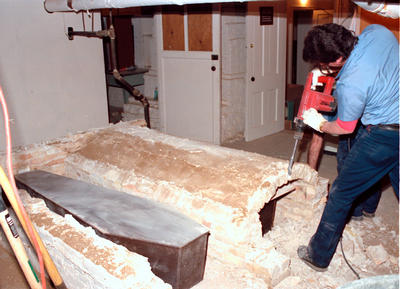
The grave marker in the basement crypt in the church had three names. The coffins were enclosed with brick and completely covered with a heavy layer of cement. When the cement and bricks were removed and the coffins opened they were surprised to find two wooden coffins, not three. The two bodies of DeSeille and Petit were in one coffin with a wood divider. The remaining coffin contained the body of Father Cointet. Fr. Jenky said the large cross and crucifix he was buried with were still intact and the buttons on his habit were crystal clear.
In verifying this information with Fr. Jenky, now Bishop Jenky, he also informed me that there was another grave in the front of the church, thought to be of a workman who died when the church was being built. An attempt was made to exhume it but it was abandoned because of the deterioration of the grave site.
There are now only two other burials remaining in the crypt of the present church. One is the body of William Phelan an early benefactor of Sorin and Notre Dame which was also moved there from the first church. After Eliza Maria Gillespie’s father died her mother, Mary, married William Phelan. When Eliza (later Sister Angela) and her brother, Neal, both joined the Holy Cross order their parents followed them to Indiana. Sister Angela became Mother Angela of the Sisters of the Holy Cross who founded St. Mary Academy in Bertrand, Michigan. It was later moved to its present site at Notre Dame and is now known as Saint Mary’s College.
The Phelans lived in a little cottage also moved to St. Mary’s that had served as a priest’s house in Bertrand. A door in the Bishop’s Chapel in the crypt of the Basilica of the Sacred Heart leads to a crawl space in the basement that is directly under the nave of the church where William Phalen’s body is buried. The other burial still in the church is that of the famous convert-journalist, Orestes Brownson, which is marked by a plaque in the middle aisle of the church in the crypt.
Patrick McGann, of the McGann Funeral Home, gave me additional information about the reburials in the Log Chapel. He explained that they took the front door and the frame off the Log Chapel and in the near left corner as you step into the chapel they made a 7 by 5 foot excavation in the ground below the flooring. The wooden coffins were fragile and turning to dust so they banded them at the head and the foot of the coffins and placed them on pieces of tin so they wouldn’t fall apart when they moved them. The two wooden coffins were then carefully lifted into new caskets and the caskets placed in burial vaults. They had to rig up a crane on the inside of the Log Chapel in order to lift them into place. The burial vaults are not buried in the dirt, they are on the floor in a crawl space under the Log Chapel. Patrick said it was so hot and dusty that day that he ruined his camera photographing it.
I am indebted to both Bishop Daniel Jenky, and Patrick McGann for providing these details to add to the record of the reburials in the Log Chapel. In the photograph below, Father Jenky reads the prayers for the dead over the remains and bestows blessings upon them.
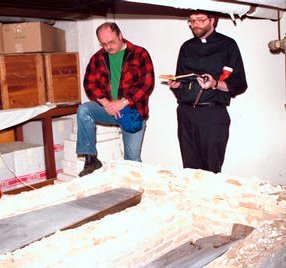
Badin’s mortal remains which were brought from St. Louis when the replica of the Log Cabin was built in 1906 are also there. His marker is on the wall of the Log Chapel. The marker for DeSeille, Petit and Cointet is in the middle of the floor. Smoke detectors and an alarm system were also installed.
A brief news article about the reburials, with photographs, appeared in the March 1987 Province Review , the Holy Cross Newsletter, but nowhere else. Father Hesburgh wanted to keep it quiet until it was accomplished. The photographs of the reburials shown here were taken by Bruce Harlan, former Director of the Notre Dame Photographic Services, now retired. Others are preserved in the University of Notre Dame Archives.
Father Sorin often repeated these thoughts about Notre Dame conveyed to him by Fr. Badin during a visit he made to the campus in later years:
Dorothy V. Corson
January 1, 2003
An extraordinary detailed description of Badin’s original Indian Chapel and its surroundings was penned by a German Missionary in the form a transcribed journal of letters to his European Doctor friend during a stay at Badin’s original Log Chapel in 1840.

He describes in vivid detail, the Log Chapel interior, the Indians camped at the lake, the services he held for the them, and the baptism of a newborn Indian baby in St. Mary’s Lake in this excerpt from his diary:
-- German missionary’s description of his stay
in the Log Chapel in 1840.